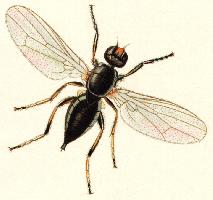
Poids et mesures
| Longueur | 4 mm |
|---|
Description de l'animal
The Cheese fly, scientifically known as Piophila casei, is a small, yet fascinating member of the Diptera order, more commonly known for flies. This species is particularly notorious for its unique and somewhat unsettling lifecycle, closely associated with cheese and other cured meat products, earning it the nickname "cheese skipper" due to the larval stage's ability to "skip" or jump distances much greater than its own body length.Adult cheese flies are small, typically measuring between 4 to 5 mm in length. They possess a dark, metallic blue to black body that glistens under direct light, with fine, bristle-like hairs covering their thorax and abdomen. Their compound eyes are large and prominent, aiding in their excellent navigational skills, while their wings, though proportionally small, enable them to make swift, precise movements.
The life cycle of Piophila casei is as intriguing as it is revolting to some. Females lay their eggs in decaying organic matter, with a strong preference for cheese and meats that are undergoing fermentation or decomposition. This unusual choice of nursery is no accident; the larvae, or maggots, thrive in these environments, feeding on the abundant microbial flora that such decomposition processes invite.
Once hatched, the larvae of Piophila casei are creamy white in color, segmented, and can reach up to 10 mm in length at full maturity. They are equipped with strong mouthparts designed for burrowing and consuming their way through their food sources. One of the most notable behaviors of these larvae is their ability to leap into the air when disturbed or in search of new feeding grounds, a feature that has fascinated and horrified observers in equal measure.
The cheese fly's life cycle is relatively quick, with the larval stage lasting approximately a week under optimal conditions before they pupate. The pupal stage is encased in a hard, brown cocoon, typically located away from the feeding site, where the transformation into an adult fly takes place. This process can last anywhere from a week to several weeks, depending on environmental conditions such as temperature and humidity.
Despite their unsavory associations, cheese flies have played a role in traditional cheese-making processes in certain cultures. For example, in Italy, the famous Casu marzu cheese relies on the digestion of Pecorino cheese by Piophila casei larvae to achieve its unique texture and flavor. However, due to health concerns, the commercial production and sale of such cheeses are highly regulated or banned in many parts of the world.
In addition to their role in traditional food production, cheese flies have attracted interest from forensic entomologists. Due to their specific habitat preferences, the presence and developmental stage of Piophila casei larvae on a decomposing body can provide valuable clues in estimating the time of death in criminal investigations.
In summary, the Cheese fly, Piophila casei, is a small but remarkable creature that plays a unique role in nature and human culture. Its lifecycle, from egg to adult, intertwined with the processes of decay and fermentation, highlights the complex interdependencies within ecosystems and the sometimes thin line between repulsion and fascination in the human experience.
Nouvelles photos d'animaux
Top 10 des animaux
- Dolphin gull (Leucophaeus scoresbii)
- Diana monkey (Cercopithecus diana)
- Moustached guenon (Cercopithecus cephus)
- Galápagos tortoise (Geochelone nigra complex)
- Russian tortoise (Testudo horsfieldii)
- Stone loach (Barbatula barbatula)
- Japanese macaque (Macaca fuscata)
- Greek tortoise (Testudo graeca)
- Common flying dragon (Draco volans)
- Vendace (Coregonus albula)